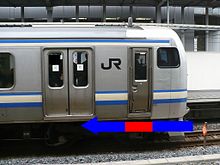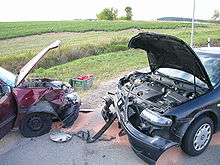



Crumple zones, crush zones,[1] or crash zones are a structural safety feature used in vehicles, mainly in automobiles, to increase the time over which a change in velocity (and consequently momentum) occurs from the impact during a collision by a controlled deformation; in recent years, it is also incorporated into trains and railcars.[2][3][4][5]
Crumple zones are designed to increase the time over which the total force from the change in momentum is applied to an occupant, as the average force applied to the occupants is inversely related to the time over which it is applied. The physics involved can be expressed by the equation:
where is the force, is the time, is the mass, and is the velocity of the body. In SI units, force is measured in Newtons, time in seconds, mass in kilograms, velocity in metres per second, and the resulting impulse is measured in newton seconds (N⋅s).
Typically, crumple zones are located in the front part of the vehicle, to absorb the impact of a head-on collision, but they may be found on other parts of the vehicle as well. According to a British Motor Insurance Repair Research Centre study of where on the vehicle impact damage occurs, 65% were front impacts, 25% rear impacts, 5% left-side, and 5% right-side.[6] Some racing cars use aluminium, composite/carbon fibre honeycomb, or energy absorbing foam[7][8] to form an impact attenuator that dissipates crash energy using a much smaller volume and lower weight than road car crumple zones.[1] Impact attenuators have also been introduced on highway maintenance vehicles in some countries.
On September 10, 2009, the ABC News programs Good Morning America and World News showed a U.S. Insurance Institute for Highway Safety crash test of a 2009 Chevrolet Malibu in an offset head-on collision with a 1959 Chevrolet Bel Air sedan. It dramatically demonstrated the effectiveness of modern car safety design over 1950s design, particularly of rigid passenger safety cells and crumple zones.[9][10]
- ^ a b Grabianowski, Ed (2008-08-11). "HowStuffWorks "How Crumple Zones Work"". HowStuffWorks. System1. Retrieved 2011-09-23.
- ^ Paul Dvorak (2003-11-06). "Will the crash zone crumple? FEA tells". Machine Design. Archived from the original on 2013-03-18. Retrieved 2016-07-17.
- ^ Grabianowski, Ed (2008-08-11). "How Crumple Zones Work - Design Compromises". HowStuffWorks. System1. Retrieved 2016-07-17.
- ^ "Physics in the Crumple Zone | Plastics Helps Save Lives". Plastics-car.com. Retrieved 2016-07-17.
- ^ "Investigating how crumple zones incorporated into modern trains make them much safer in collisions" (PDF). Archived from the original (PDF) on 2007-03-06. Retrieved 2016-07-17.
- ^ A. Robinson; W.A. Livesey (2006). The Repair of Vehicle Bodies P.406. 5th Edition. Butterworth-Heinemann. ISBN 978-0-7506-6753-1.
- ^ "Standard Impact Attenuator Design". Retrieved 2016-07-17.
- ^ "Standard Impact Attenuator". Retrieved 2016-07-17.
- ^ Stark, Lisa (2009-09-10). "Highway Safety Exclusive: Car Crashes, Travel Deaths Prevented by Technology — ABC News". Abcnews.go.com. Retrieved 2011-09-23.
- ^ Neff, John. "Pics Aplenty: IIHS reveals before and after of Malibu/Bel Air crash". Autoblog.com. Retrieved 2011-09-23.




